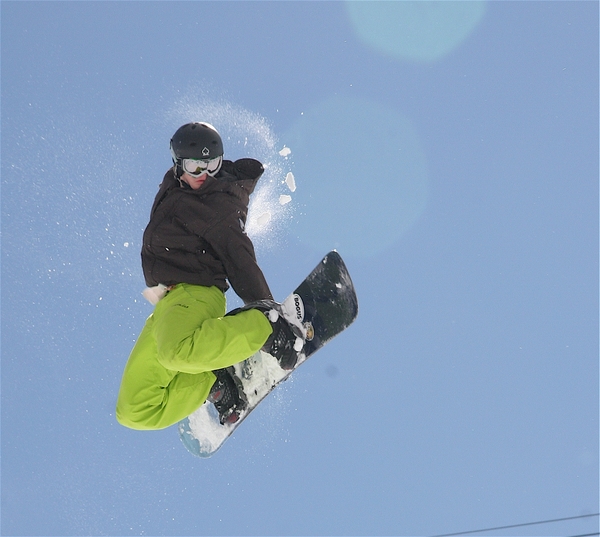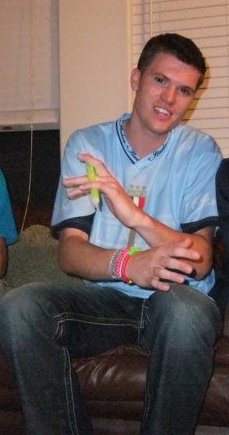
For seventeen years, Parker Smith was a healthy, vibrant, everyday kid. Growing up in Idaho, he loved playing sports, having fun with family and friends, bicycling, wakeboarding and water skiing in the summertime, and snowboarding in the winter. He had a zest for life. His life was in a harmonic balance — as long as he was active.
But that balance would soon get off kilter. Within a year, Parker would find himself concerned daily about small things that most teenagers wouldn’t even give a second thought about — how he would reach for a glass high above his head, shampoo his hair or even high five a friend. Doing these mundane activities would cause him pain, stress and frustration. Now twenty years old, this same young man is being forced to take a semester off from his sophomore year of college at Boise State University so he can once and for all put an end to the bad dream that has taken over his life.
From Normal to Anomalous
Parker was a junior in high school when he tried out for the football team and earned a spot as a cornerback. Early in the season, he was injured when impact with an opposite team member caused his collarbone to pop out of its socket. At that time, he was able to secure the dislocated collarbone back into place and continue playing. But in the days and weeks that followed, lifting his arm overhead and doing simple things such as putting on a shirt became difficult.
Still sore and experiencing symptoms from the initial injury, Parker continued to play, but his collarbone region proved to be too painful and too stressful because with every hit on the field, his collarbone continued to partially dislocate (subluxate). This subluxation, which began on his right side, quickly began happening to his left medial sternoclavicular joint as well. Sports managers at times could not get the dislocated collarbone back into place and multiple trips to local sports medicine clinics, chiropractors and the emergency room were made.
Reluctantly, Parker was not able to continue playing football and over the course of the next several years, the injury that took him off the field would continue to make life difficult and create numerous setbacks. Monthly, weekly and daily his collarbones would continue to dislocate and pop out. He entered college at Boise State and tried to deal with the situation as best he could. Life became a constant reminder that it could happen again at any moment and while other kids were living the carefree, happy-go-lucky college life, Parker spent countless hours dealing with pain management.
“I Can’t Fix it”
Dozens of doctors — including orthopedic specialists, cardiothoracic surgeons and chiropractors –examined Parker and they all agreed that Parker suffered from a congenital condition of joint instability causing the dislocated collarbone and shoulder dislocation. This might have gone on undetected forever had it not been for that one initial hit on the football field. His specific injury, anterior chronic bilateral medial sternoclavicular joint subluxation, is rare and hard to repair.
“I spent months visiting doctors, having x-rays and MRIs — even an ultrasound. Most of the doctors that saw me figured out what I had, but none of them were willing to touch me. They really didn’t know how to solve my problem. Every time it was a huge disappointment. And as time went on, the news was harder to hear and my condition only became worse and more painful,” says Parker. “The initial strategy was to hope that the condition would improve on its own as the growth plate in the middle of my chest closed up, but unfortunately, that didn’t happen.”
Parkers mom, Amy, agrees, “It was so hard to watch Parker go through every day having to focus on managing his pain. His collarbones were popping out about fifteen times per day on each side for three years. It was affecting him in so many ways. He wasn’t able to be the free-spirited college student that all young adults deserve to be. It was difficult not to lose hope that he could ever be normal again.”
The final straw occurred in October of 2010. Parker was winterizing the family boat when the metal wakeboarding tower unexpectedly swung loose, hitting him on his right shoulder. His collarbone blew out of its socket and this time, even an extensive emergency room visit couldn’t restore his collarbone to its proper placement.
Finally, Amy followed up on leads for the Steadman Clinic in Vail, CO and to Dr. Millett in particular. “I hadn’t contacted Dr. Millett earlier because I assumed he only worked on pro athletes. But I was really feeling frantic and decided to see what he had to say. I was elated when Dr. Millett emailed me back in about an hour—after three years of being shut down by other doctors!”
“I looked all over Dr. Millett’s website and learned he had experience with shoulder dislocation, dislocated collarbones and most importantly chronic sternoclavicular joint subluxation” said Parker. “I was impressed and eager to talk to him. Later, my mom and I talked to him on the phone and explained to him what I had been dealing with. He was very confident that he could help me. A few weeks later, in early December 2010, we were on our way to Vail. We pretty much knew that we weren’t coming back to Idaho without stitches in my chest.”
 Prayers Answered
Prayers Answered
When Parker and his mom arrived in Vail, they met with Dr. Millett. “I felt like I already knew him from communicating with him on email and the phone,” said Parker. “But when he was standing in front of me, looking at my injury, calmly evaluating my condition, that is what sealed the deal. He was confident, capable and knew what to do.”
Though Dr. Millett admitted that Parker’s sternoclavicular joint subluxation was a very rare condition that you don’t see all the time, he had repaired SC joints on other patients and was ready to operate. The next day, they were in surgery. Dr. Millett performed a right shoulder sternoclavicular joint reconstruction with a free gracilis autograft. To secure the collarbone joint, he used tendons from Parker’s hamstring tendon in his leg and placed them over the SC joint to rebuild it and lock it into place. Parker would spend one night in the hospital for observation and two more weeks in Vail so that Dr. Millett and his team could monitor the surgical site.
Finally, at the end of December, just in time for the holidays, Parker returned to Idaho. His next goal was to adhere to the strict rehab program that Dr. Millett prescribed and began visiting his physical therapist daily. By mid-January, Parker felt major improvement. By this time, he was able to lift his arm overhead without experiencing any popping or dislocation, and his pain level was at a minimum.
While great improvement was made on Parker’s right collarbone, the left side was continuing to create consistent pain and instability; After consulting with Dr. Millett, they agreed that the left side would be next for the same surgery. Parker decided to take a semester off from college and he is scheduled for surgery in March 2011. He will re-enroll in college in the fall with both sides of his collarbone repaired — and with a new lease on life.
According to Amy, “Dr. Millett was truly the answer to our prayers. It was a huge relief. Parker was living a life that no one — certainly not a twenty year old — should have to endure. The expertise we experienced at the Steadman Clinic was life transforming for our entire family. I actually cried when Dr. Millett told us he could fix this. I’m giddy again with hope.”
